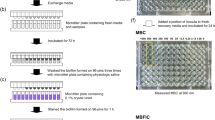Summary
-
1.
A ringdish method is described, and the results are compared with those obtained by the agar plate method with Petridishes in testing catechol, guaiacol, α-naphthol, and tannin for the detection of phenoloxidases in Collybia velutipes, Pleurotus ostreatus and Polystictus versicolor.
-
2.
Petridish covers are used as upper parts of ringdishes; the bottom parts are subdivided in a central compartment, a test zone and a marginal zone.
-
3.
In the usual agar plate method with Petridishes, the sensitive inocula are exposed immediately to the influence of test substrates, whilst in the ringdish test the mycelia develop on nutrient agar in the central compartment and gain contact with the test substrate only during transition growth in the test zone. Thus, in case of toxic effects higher substrate concentrations may be used in the ringdish test in comparison with the agar plate method.
-
4.
Catechol proved to be less qualified for routine investigations on the detection of phenoloxidases by reason of autoxidative discolourations and due to the toxicity of its oxidation products. The ringdish test, however, offers the possibility to examine the toxic effect of the oxidation products on enzymes of the carbohydrate metabolism of fungi. Whilst in ringdish tests with guaiacol and α-naphthol some interfering influence—possible by watersteam volatility—could not yet be eliminated, tannin appeared to be the best substrate among the tested phenolic compounds.
Zusammenfassung
-
1.
Die Methodik eines Ringschalentests wird beschrieben. Die Ergebnisse bei der Prüfung von Brenzcatechin, Guajacol, α-Naphthol und Tannin für den Nachweis von Phenoloxidasen bei Collybia velutipes, Pleurotus ostreatus und Polystictus versicolor werden mit den Befunden entsprechender Untersuchungen auf Agarplatten in Petrischalen verglichen.
-
2.
Der Oberteil der Ringschalen besteht aus einem Petrischalendeckel, der Unterteil ist durch zwei konzentrische Ringe von halber Randhöhe in Zentralfeld, Testzone und Randzone aufgeteilt.
-
3.
Während beim üblichen Agarplattenverfahren mit Petrischalen die Impfstücke unmittelbar der Einwirkung des Testsubstrates ausgesetzt werden, kommt beim Ringschalentest das im Zentralfeld auf Nähragar gebildete Mycel erst nach Überwachsen auf die Testzone mit dem zu prüfenden Substrat in Kontakt. Bei toxischer Wirksamkeit können die Substratkonzentrationen daher beim Ringschalentest meist höher angesetzt werden als beim Agraplattenverfahren.
-
4.
Brenzcatechin ist wegen autoxydativer Verfärbungen und wegen der Toxicität der Oxydationsprodukte für Routineuntersuchungen zum Phenoloxidasennachweis weniger geeignet, dock kann im Ringschalentest die toxische Wirkung der Oxydationsprodukte auf Enzyme des Kohlenhydratstoffwechsels der Pilze überprüft werden. Während mit Guajacol und α-Naphthol Störungen beim Ringschalentest — vermutlich durch Wasserdampfflüchtigkeit — noch nicht ausgeschaltet werden konnten, erwies sich Tannin als besonders geeignet.
Similar content being viewed by others
Literatur
Bavendamm, W.: Über das Vorkommen und den Nachweis von Oxydasen bei holzzerstörenden Pilzen. Z. Pfl.-Krankh. Pfl.-Schutz 38, 257–276 (1928).
Küster, E.: Humusbildung und Phenoloxydasen bei Streptomyceten. Z. Pfl.-Ern., Düngung, Bodenk. 69 (114), 137–142 (1955).
—: Phenoloxidase in streptomycetes. In: Enzyme chemistry of phenolic compounds. pp. 81–86. Ed. by J. B. Pridham. Oxford-London-New York-Paris: Pergamon Press 1963.
Lyr, H.: Über den Nachweis von Oxydasen und Peroxydasen bei höheren Pilzen und die Bedeutung dieser Enzyme für die Bavendamm-Reaktion. Planta (Berl.) 50, 359–370 (1958a).
—: Die Induktion der Laccase-Bildung bei Collybia velutipes Curt. Arch. Mikrobiol. 28, 310–324 (1958b).
—: On the toxicity of oxidized polyphenols. Phytopath. Z. 52, 229–240 (1965).
Mc Ilvaine, Sörensen: In: Biochem. Taschenb. Teil II, 2. Aufl. Hrsg. v. H. M. Rauen. Berlin-Göttingen-Heidelberg: Springer 1964.
Sevcik, V.: Occurrence of phenol oxidase in Streptomyces antibioticus producing Actinomycin B. Nature (Lond.) 179, 1191–1192 (1957).
Author information
Authors and Affiliations
Rights and permissions
About this article
Cite this article
Rösch, R., Liese, W. Ringschalentest mit holzzerstörenden Pilzen. Arch. Mikrobiol. 73, 281–292 (1970). https://doi.org/10.1007/BF00410629
Received:
Issue Date:
DOI: https://doi.org/10.1007/BF00410629




